

The Crown Jewels, which are used today in Coronations and other ceremonial events in the United Kingdom, are the regalia that have been used by English kings and queens since 1660 or earlier. The Crown Jewels are part of the national heritage and held by The Queen as Sovereign. The collection includes regalia (those items used at a coronation), other crowns and pieces donated by various sovereigns, church and banqueting plate, orders, insignia, robes, a unique collection of medals and royal christening fonts.
Apart of those jewels listed and analysed in this page, several other ought to be mentioned, most notably the fantastic Jewelled Sword of State, one of the five swords of state carried in procession and displayed during the Coronation ceremony. The Jewelled Sword of State is the one presented to the sovereign during the ritual. The hilt and scabbard are in gold set with jewels and in the scabbard the jewels form the Rose, the Thistle and the Shamrock, the national symbols of England, Scotland and Ireland, respectively. The blade is of Damascus engraved steel.
The Coronation ring has a large sapphire in its centre, surrounded by diamonds. Over the sapphire are laid five rubies representing St. George’s cross. It is often called the wedding ring of England. An ancient belief says the tighter the ring is to the sovereign’s finger, the longer and more successful will be the reign. The gold Armills represent sincerity and wisdom and the Golden Spurs are the emblems of knighthood and chivalry. The Golden Spurs date from around 1661, while new Armills were offered to the Queen by the Commonwealth in 1953.
 This historic chair is named either St. Edward’s Chair, it’s original name, and Coronation Chair. It used to be a gilded chair, encrusted with sparkling glass and enamels, but that was before it was vandalised. Beneath it used to be the Stone of Scone, the ancient coronation seat of the Scottish kings, which was seized from the Scots in 1290 by King Edward I. The Stone of Scone, which is pronounced “scoon”, remained in the Abbey until 1996 (expect between 1950 and 1951, when it was stolen by Scottish nationalists), when it finally was returned to Edinburgh Castle.
This historic chair is named either St. Edward’s Chair, it’s original name, and Coronation Chair. It used to be a gilded chair, encrusted with sparkling glass and enamels, but that was before it was vandalised. Beneath it used to be the Stone of Scone, the ancient coronation seat of the Scottish kings, which was seized from the Scots in 1290 by King Edward I. The Stone of Scone, which is pronounced “scoon”, remained in the Abbey until 1996 (expect between 1950 and 1951, when it was stolen by Scottish nationalists), when it finally was returned to Edinburgh Castle.
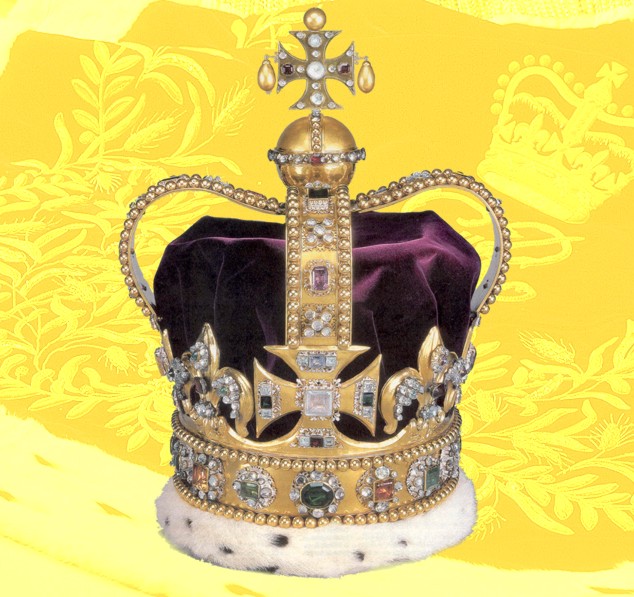 One of the most elegant pieces of the Crown Jewels, St. Edward’s Crown plays a central role in the Coronation ceremony. It was made on orders of King Charles II and has been used for every coronation since, although not used for the actual crowning of Kings George IV and William IV, nor for the crowning of Queen Victoria, who judged it too heavy. The gold crown is set with precious and semi-precious stones. The crown is decorated with four alternate crosses-patées and fleur-de-lys and inside the arches is the Cap of Estate, in purple velvet.
One of the most elegant pieces of the Crown Jewels, St. Edward’s Crown plays a central role in the Coronation ceremony. It was made on orders of King Charles II and has been used for every coronation since, although not used for the actual crowning of Kings George IV and William IV, nor for the crowning of Queen Victoria, who judged it too heavy. The gold crown is set with precious and semi-precious stones. The crown is decorated with four alternate crosses-patées and fleur-de-lys and inside the arches is the Cap of Estate, in purple velvet.
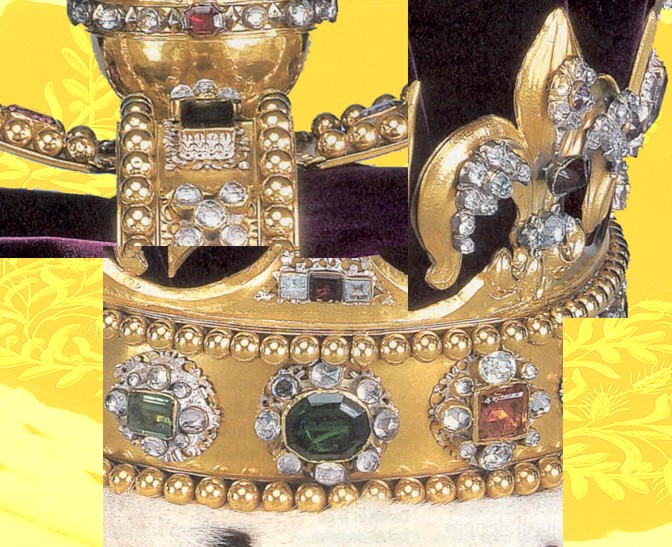 Some details of St. Edward's Crown.
Some details of St. Edward's Crown.
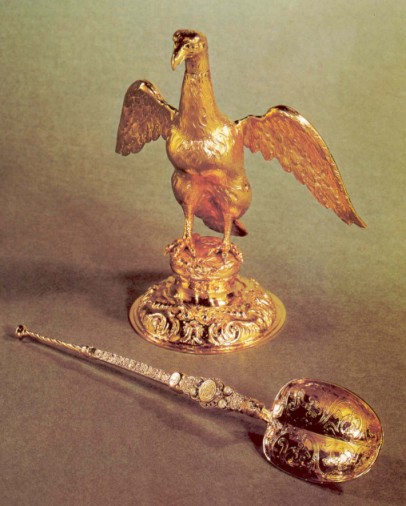 The anointing is a central part of the coronation ceremony. The Archbishop of Canterbury anoints the Sovereign on his/her hands, breast and head, using the ampulla and spoon. The ampulla (dated 1661) is a golden eagle flask which holds the holy oil used in the anointing, whilst the spoon is the oldest piece in the regalia, probably made for King Henry II or King Richard I.
The anointing is a central part of the coronation ceremony. The Archbishop of Canterbury anoints the Sovereign on his/her hands, breast and head, using the ampulla and spoon. The ampulla (dated 1661) is a golden eagle flask which holds the holy oil used in the anointing, whilst the spoon is the oldest piece in the regalia, probably made for King Henry II or King Richard I.
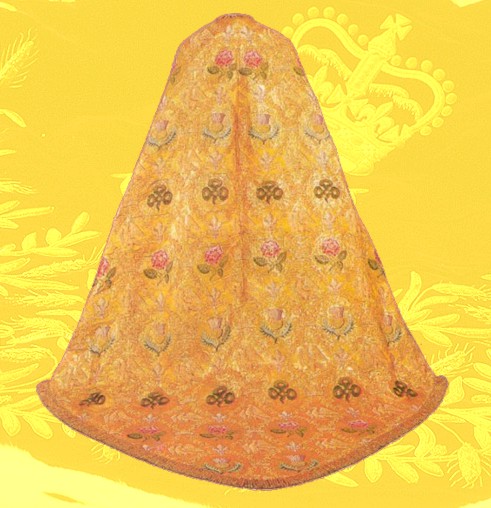 This superb robe in cloth of gold is one of the clothes with which the Queen was invested during the Coronation ceremony. It is called the Imperial Mantle or Pallium Regale and is matched by the Stole Royal. It is said that the materials of which this magnificent garment is made may be descended from the Imperial Robes of the Byzantine Emperors. In this form it dates from 1821, and the designs are the Rose, the Thistle and the Shamrock.
This superb robe in cloth of gold is one of the clothes with which the Queen was invested during the Coronation ceremony. It is called the Imperial Mantle or Pallium Regale and is matched by the Stole Royal. It is said that the materials of which this magnificent garment is made may be descended from the Imperial Robes of the Byzantine Emperors. In this form it dates from 1821, and the designs are the Rose, the Thistle and the Shamrock.
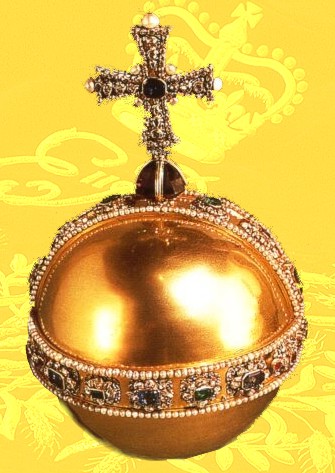 The Sovereign's Orb (representing Christian sovereignty, the Sovereign being the head of the Church of England) is placed in the Sovereign's right hand. The Orb was made for King Charles II's coronation, set with precious stones and pearls for a total cost of £1,150.
The Sovereign's Orb (representing Christian sovereignty, the Sovereign being the head of the Church of England) is placed in the Sovereign's right hand. The Orb was made for King Charles II's coronation, set with precious stones and pearls for a total cost of £1,150.
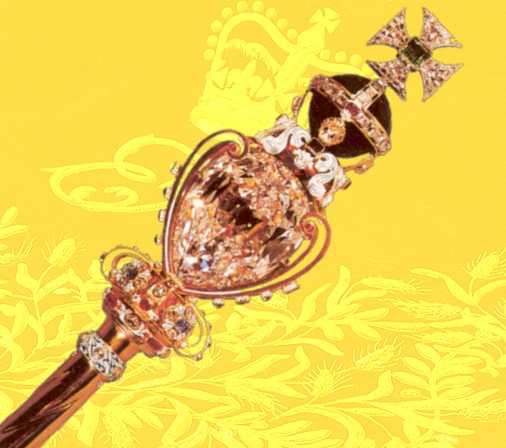 The Sceptre with the Cross, symbolising the Sovereign's temporal power under the Cross. The first recorded appearance of the sceptre in the coronation dates from the ninth century. The biggest existing diamond – the Cullinan I, the First Star of Africa, weighting 530 carats – is set in the Sceptre with the Cross. It was cut from the biggest diamond ever found, weighting then some 3.106 carats, which was offered to King Edward VII on his birthday in 1907.
The Sceptre with the Cross, symbolising the Sovereign's temporal power under the Cross. The first recorded appearance of the sceptre in the coronation dates from the ninth century. The biggest existing diamond – the Cullinan I, the First Star of Africa, weighting 530 carats – is set in the Sceptre with the Cross. It was cut from the biggest diamond ever found, weighting then some 3.106 carats, which was offered to King Edward VII on his birthday in 1907.
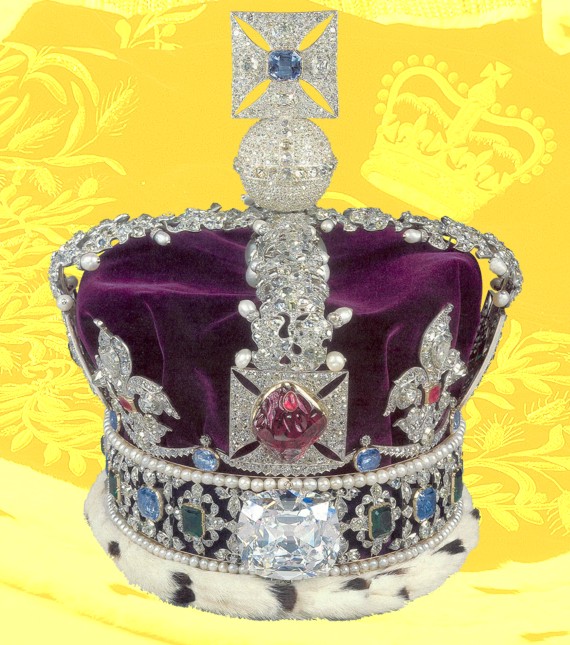 Certainly the most valuable piece of the Crown Jewels and the one that bears more historic stones, the Imperial State Crown is one of the most beautiful pieces of jewellry ever made. Using jewels used in previous crowns, this crown was made for King George VI’s Coronation in 1937. On the very front it bears the Cullinan II, the Second Star of Africa, cut from the gigantic stone offered to King Edward VII. Above the diamond is the famous Black Prince’s Ruby: however, the big red stone is actually a spinel, which nevertheless has a small ruby incrusted. In the middle of the Maltese cross, on the top, is the Sapphire of King Edward, the Confessor (said to have come from Edward, the Confessor’s coronation ring).
Certainly the most valuable piece of the Crown Jewels and the one that bears more historic stones, the Imperial State Crown is one of the most beautiful pieces of jewellry ever made. Using jewels used in previous crowns, this crown was made for King George VI’s Coronation in 1937. On the very front it bears the Cullinan II, the Second Star of Africa, cut from the gigantic stone offered to King Edward VII. Above the diamond is the famous Black Prince’s Ruby: however, the big red stone is actually a spinel, which nevertheless has a small ruby incrusted. In the middle of the Maltese cross, on the top, is the Sapphire of King Edward, the Confessor (said to have come from Edward, the Confessor’s coronation ring).
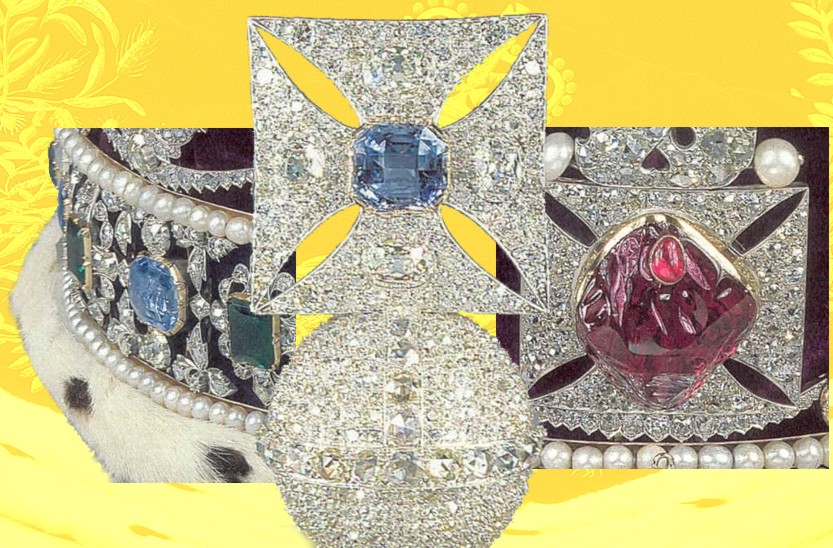 Some details of the Imperial State Crown.
Some details of the Imperial State Crown.
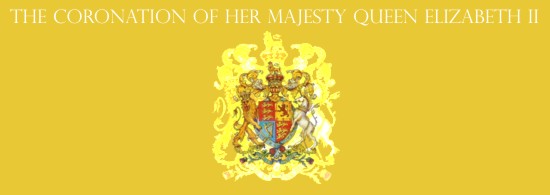
Index Page
Previous Page











